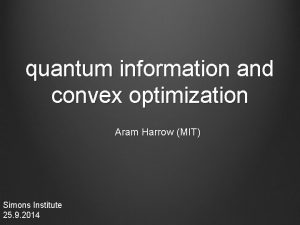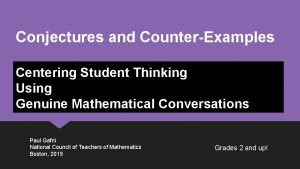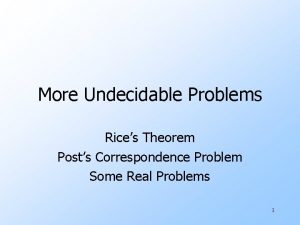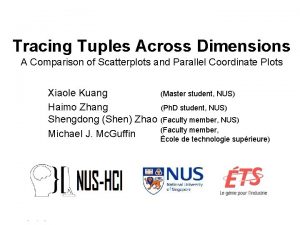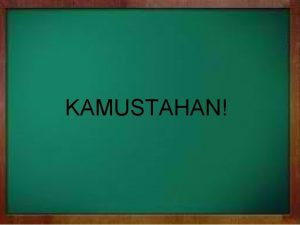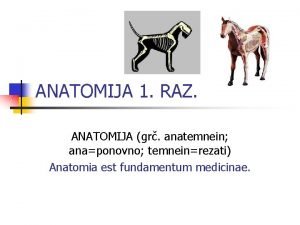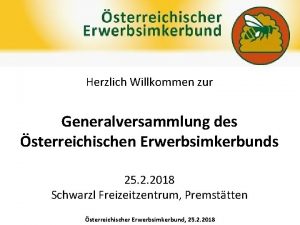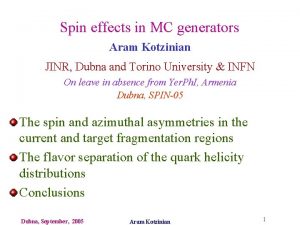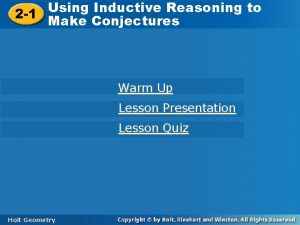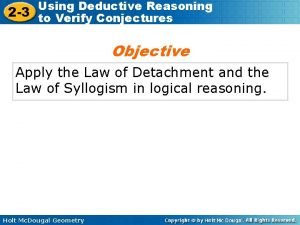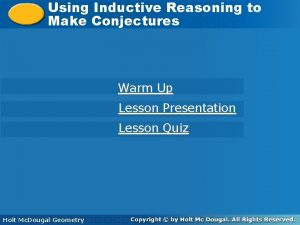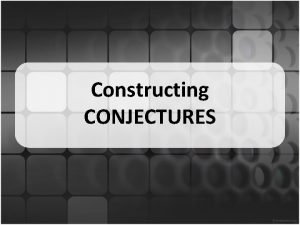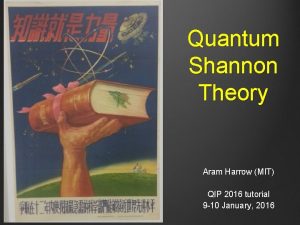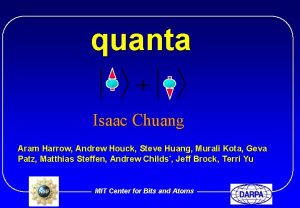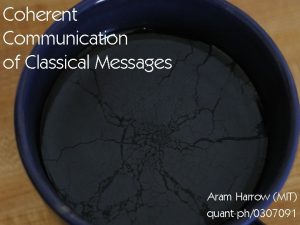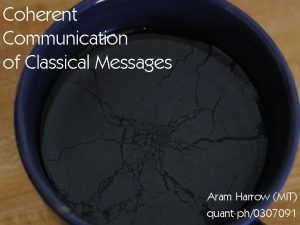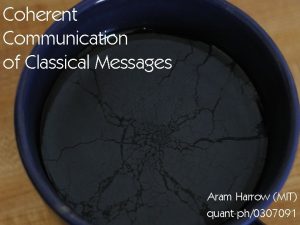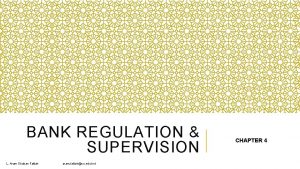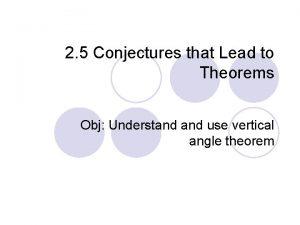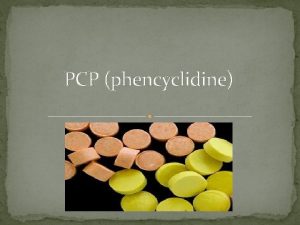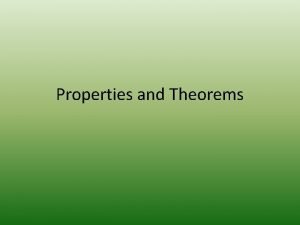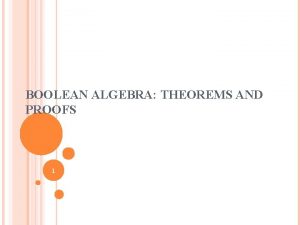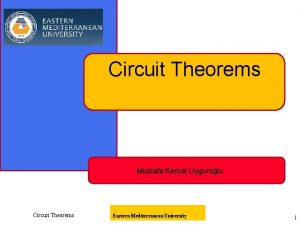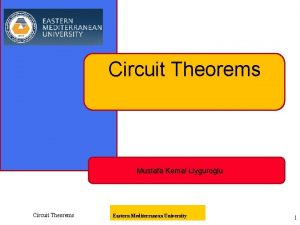de Finetti theorems and PCP conjectures Aram Harrow


![Quantum de Finetti Theorem [Christandl, Koenig, Mitchison, Renner ‘ 06] Given a state exists Quantum de Finetti Theorem [Christandl, Koenig, Mitchison, Renner ‘ 06] Given a state exists](https://slidetodoc.com/presentation_image_h/33fb47fdd2d3d8921a35b422c128818b/image-3.jpg)

![Quantum de Finetti theorem Theorem [Christandl, Koenig, Mitchison, Renner ‘ 06] Given a state Quantum de Finetti theorem Theorem [Christandl, Koenig, Mitchison, Renner ‘ 06] Given a state](https://slidetodoc.com/presentation_image_h/33fb47fdd2d3d8921a35b422c128818b/image-5.jpg)
![relaxed/improved versions Two examples known: 1. Exponential de Finetti Theorem: [Renner ’ 07] error relaxed/improved versions Two examples known: 1. Exponential de Finetti Theorem: [Renner ’ 07] error](https://slidetodoc.com/presentation_image_h/33fb47fdd2d3d8921a35b422c128818b/image-6.jpg)







![previous results • [Bell ’ 64] There exist G with ωe(G) > ωc(G) • previous results • [Bell ’ 64] There exist G with ωe(G) > ωc(G) •](https://slidetodoc.com/presentation_image_h/33fb47fdd2d3d8921a35b422c128818b/image-14.jpg)




![de Finetti without symmetry Theorem [Christandl, Koenig, Mitchison, Renner ‘ 05] Given a state de Finetti without symmetry Theorem [Christandl, Koenig, Mitchison, Renner ‘ 05] Given a state](https://slidetodoc.com/presentation_image_h/33fb47fdd2d3d8921a35b422c128818b/image-19.jpg)








- Slides: 27

de Finetti theorems and PCP conjectures Aram Harrow (MIT) DAMTP, 26 Mar 2013 based on ar. Xiv: 1210. 6367 + ar. Xiv: 13? ? joint work with Fernando Brandão (UCL)

Symmetric States is permutation symmetric in the B subsystems if for every permutation π, … A B 1 B 2 Bn 1 B 4 B 3 Bn = … A B 1 B 2 B 3 B 4 Bn 1 Bn
![Quantum de Finetti Theorem Christandl Koenig Mitchison Renner 06 Given a state exists Quantum de Finetti Theorem [Christandl, Koenig, Mitchison, Renner ‘ 06] Given a state exists](https://slidetodoc.com/presentation_image_h/33fb47fdd2d3d8921a35b422c128818b/image-3.jpg)
Quantum de Finetti Theorem [Christandl, Koenig, Mitchison, Renner ‘ 06] Given a state exists µ such that symmetric under exchange of B 1…Bn, there builds on work by [Størmer ’ 69], [Hudson, Moody ’ 76], [Raggio, Werner ’ 89] [Caves, Fuchs, Schack ‘ 01], [Koenig, Renner ‘ 05] Proof idea: Perform an informationally complete measurement of n k B systems. Applications: information theory: tomography, QKD, hypothesis testing algorithms: approximating separable states, mean field theory

Quantum de Finetti Theorem as Monogamy of Entanglement Definition: ρAB is n extendable if there exists an extension with for each i. all quantum states (= 1 extendable) 2 extendable 100 extendable separable = ∞ extendable Algorithms: Can search/optimize over n extendable states in time d. O(n). Question: How close are n extendable states to separable states?
![Quantum de Finetti theorem Theorem Christandl Koenig Mitchison Renner 06 Given a state Quantum de Finetti theorem Theorem [Christandl, Koenig, Mitchison, Renner ‘ 06] Given a state](https://slidetodoc.com/presentation_image_h/33fb47fdd2d3d8921a35b422c128818b/image-5.jpg)
Quantum de Finetti theorem Theorem [Christandl, Koenig, Mitchison, Renner ‘ 06] Given a state exists µ such that symmetric under exchange of B 1…Bn, there Difficulty: 1. Parameters are, in many cases, too weak. 2. They are also essentially tight. Way forward: 1. Change definitions (of error or i. i. d. ) 2. Obtain better scaling
![relaxedimproved versions Two examples known 1 Exponential de Finetti Theorem Renner 07 error relaxed/improved versions Two examples known: 1. Exponential de Finetti Theorem: [Renner ’ 07] error](https://slidetodoc.com/presentation_image_h/33fb47fdd2d3d8921a35b422c128818b/image-6.jpg)
relaxed/improved versions Two examples known: 1. Exponential de Finetti Theorem: [Renner ’ 07] error term exp( Ω(n k)). Target state convex combination of “almost i. i. d. ” states. 2. measure error in 1 LOCC norm [Brandão, Christandl, Yard ’ 10] For error ε and k=1, requires n ~ ε 2 log|A|. This talk improved de Finetti theorems for local measurements

main idea use information theory log |A| ≥ I(A: B 1…Bn) = I(A: B 1) + I(A: B 2|B 1) + … + I(A: Bn|B 1…Bn 1) repeatedly uses chain rule: I(A: BC) = I(A: B) + I(A: C|B) I(A: Bt|B 1…Bt 1) ≤ log(|A|)/n for some t≤n. If B 1…Bn were classical, then we would have ≈separable Question: How to make B 1…n classical? distribution on B 1…Bt 1 ≈product state (cf. Pinsker ineq. )

Answer: measure! Fix a measurement M: B Y. I(A: Bt|B 1…Bt 1) ≤ εfor the measured state (id ⊗ M ⊗n )(ρ). Then • ρAB is hard to distinguish from σ∈Sep if we first apply (id⊗M) • || (id⊗M)(ρ-σ)|| ≤ small for some σ∈Sep. Theorem Given a state symmetric under exchange of B 1…Bn, and {Λr} a collection of operations from A X, Cor: setting Λ=id recovers [Brandão, Christandl, Yard ’ 10] 1 LOCC result.

beware: X is quantum the proof Friendly advice: You can find these equations in 1210. 6367.

advantages/extensions Theorem Given a state symmetric under exchange of B 1…Bn, and {Λr} a collection of operations from A X, 1. 2. 3. 4. 5. 6. Simpler proof and better constants Bound depends on |X| instead of |A| (A can be ∞ dim) Applies to general non signalling distributions There is a multipartite version (multiply error by k) Efficient “rounding” (i. e. σ is explicit) Symmetry isn’t required

applications • nonlocal games Adding symmetric provers “immunizes” against entanglement / non signalling boxes. (Caveat: needs uncorrelated questions. ) Conjectured improvement would yield NP hardness for 4 players. • Bell. QMA(poly) = QMA Proves Chen Drucker SAT∈Bell. QMA log(n)(√n) protocol is optimal. • pretty good tomography [Aaronson ’ 06] on permutation symmetric states (instead of product states) • convergence of Lasserre hierarchy for polynomial optimization see also 1205. 4484 for connections to small set expansion

non local games |Ãi x r y q

non local games |Ãi Non Local Game G(π, V): π(r, q): distribution on R x Q V(x, y|r, q): predicate on X x Y x R x Q x r y q Classical value: Quantum value: sup over measurements and |Ãi of unbounded dim
![previous results Bell 64 There exist G with ωeG ωcG previous results • [Bell ’ 64] There exist G with ωe(G) > ωc(G) •](https://slidetodoc.com/presentation_image_h/33fb47fdd2d3d8921a35b422c128818b/image-14.jpg)
previous results • [Bell ’ 64] There exist G with ωe(G) > ωc(G) • PCP theorem [Arora et al ‘ 98 and Raz ’ 98] For any ε>0, it is NP complete to determine whether ωc < ε or ωc > 1 ε(even for XOR games). • [Cleve, Høyer, Toner, Watrous ’ 04] Poly time algorithm to compute ωe for two player XOR games. • [Kempe, Kobayashi, Matsumoto, Toner, Vidick ’ 07] NP hard to distinguish ωe(G) = 1 from ωe(G) < 1 1/poly(|G|) • [Ito Vidick ‘ 12 and Vidick ’ 13] NP hard to distinguish ωe(G) > 1 ε from ωe(G) < ½ +ε for three player XOR games

immunizing against entanglement |Ãi x r y 1 q y 2 q y 3 q y 4 q

complexity of non local games Cor: Let G(π, V) be a 2 player free game with questions in R×Q and answers in X×Y, where π=πR⊗πQ. Then there exists an (n+1) player game G’(π’, V’) with questions in R×(Q 1×…×Qn) and answers in X×(Y 1×…×Yn), such that Implies: 1. an exp(log(|X|) log(|Y|)) algo for approximating ωc 2. ωe is hard to approximate for free games.

why free games? Theorem Given a state symmetric under exchange of B 1…Bn, and {Λr} a collection of operations from A X, ∃σ ∀q for most r ρ and σ give similar answers Conjecture Given a state symmetric under exchange of B 1…Bn, and {Λr} a collection of operations from A X, • Would give alternate proof of Vidick result. • FALSE for non signalling distributions.

QCC…C de Finetti Theorem If exists µ s. t. is permutation symmetric then for every k there Applications • QMA = QMA with multiple provers and Bell measurements • convergence of sum of squares hierarchy for polynomial optimization • Aaronson’s pretty good tomography with symmetric states
![de Finetti without symmetry Theorem Christandl Koenig Mitchison Renner 05 Given a state de Finetti without symmetry Theorem [Christandl, Koenig, Mitchison, Renner ‘ 05] Given a state](https://slidetodoc.com/presentation_image_h/33fb47fdd2d3d8921a35b422c128818b/image-19.jpg)
de Finetti without symmetry Theorem [Christandl, Koenig, Mitchison, Renner ‘ 05] Given a state , there exists µ such that Theorem For ρ a state on A 1 A 2…An and any t ≤ n k, there exists m≤t such that where σ is the state resulting from measuring j 1, …, jm and obtaining outcomes a 1, …, am.

PCP theorem Classical k CSPs: Given constraints C={Ci}, choose an assignment σ mapping n variables to an alphabet ∑ to minimize the fraction of unsatisfied constraints. UNSAT(C) = minσ Pri [σ fails to satisfy Ci] Example: 3 SAT: NP hard to determine if UNSAT(C)=0 or UNSAT(C) ≥ 1/n 3 PCP (probabilistically checkable proof) theorem: NP hard to determine if UNSAT(C)=0 or UNSAT(C) ≥ 0. 1

Local Hamiltonian problem LOCAL HAM: k local Hamiltonian ground state energy estimation Let H = �� i Hi, with each Hi acting on k qubits, and ||Hi||≤ 1 i. e. Hi = Hi, 1 ⊗ Hi, 2 ⊗ … ⊗ Hi, n, with #{j : Hi, j≠I} ≤ k Goal: Estimate E 0 = minψhÃ|H|Ãi = min½ tr Hρ Hardness • Includes k CSPs, so ± 0. 1 error is NP hard by PCP theorem. • QMA complete with 1/poly(n) error [Kitaev ’ 99] QMA = quantum proof, bounded error polytime quantum verifier Quantum PCP conjecture LOCAL HAM is QMA hard for some constant error ε>0. Can assume k=2 WLOG [Bravyi, Di. Vincenzo, Terhal, Loss ‘ 08]

high degree in NP Theorem It is NP complete to estimate E 0 for n qudits on a D regular graph to additive error » d / D 1/8. Idea: use product states E 0 ≈ min tr H(Ã1 … Ãn) – O(d/D 1/8) By constrast 2 CSPs are NP hard to approximate to error |§|®/D¯ for any ®, ¯>0

intuition: mean field theory 1 D 2 D 3 D ∞ D

Proof of PCP no go theorem 1. Measure εn qudits and condition on outcomes. Incur error ε. 2. Most pairs of other qudits would have mutual information ≤ log(d) / εD if measured. 3. Thus their state is within distance d 3(log(d) / εD)1/2 of product. 4. Witness is a global product state. Total error is ε + d 3(log(d) / εD)1/2. Choose ε to balance these terms.

other applications PTAS for Dense k local Hamiltonians improves on 1/dk 1 +εapproximation from [Gharibian Kempe ’ 11] PTAS for planar graphs Builds on [Bansal, Bravyi, Terhal ’ 07] PTAS for bounded degree planar graphs Algorithms for graphs with low threshold rank Extends result of [Barak, Raghavendra, Steurer ’ 11]. run time for ε approximation is exp(log(n) poly(d/ε) ⋅#{eigs of adj. matrix ≥ poly(ε/d)})

open questions • Is QMA(2) = QMA? Is SAT∈QMA √n(2)1, 1/2 optimal? (Would follow from replacing 1 LOCC with SEP YES. ) • Can we reorder our quantifiers to get a dimension independent bound for correlated local measurements? • (Especially if your name is Graeme Mitchison) Representation theory results > de Finetti theorems What about the other direction? • The usual de Finetti questions: • better counter examples • how much does it help to add PPT constraints? • The unique games conjecture is ≈equivalent to determining whether max {tr Mρ: ρ∈Sep} is ≥c 1/d or ≤c 2/d for c 1≫c 2≫ 1 and M a LO measurement. Can we get an algorithm for this using de Finetti? • Weak additivity? The Quantum PCP conjecture? ar. Xiv: 1210. 6367

 Aram harrow
Aram harrow Bobaram
Bobaram Gafni
Gafni Pcp ppi
Pcp ppi Pcp scitt
Pcp scitt If pcp is decidable then mpcp is
If pcp is decidable then mpcp is Pcp treatment
Pcp treatment Pcp vs scp
Pcp vs scp Pcp ii 65
Pcp ii 65 Pcp
Pcp Fsma pcp
Fsma pcp Pcp droge
Pcp droge Regio occipitalis
Regio occipitalis Como o pcp ajuda a empresa a se tornar competitiva
Como o pcp ajuda a empresa a se tornar competitiva Spc forum
Spc forum Lieve bos
Lieve bos Pcpkey
Pcpkey Scientific name for pcp
Scientific name for pcp Pcp id number lookup harvard pilgrim
Pcp id number lookup harvard pilgrim Elektromos áram kémiai hatása
Elektromos áram kémiai hatása Imkermarkt 24
Imkermarkt 24 Aram aristakesyan
Aram aristakesyan Aram yeretzian
Aram yeretzian Aram generator
Aram generator Mom mátészalka
Mom mátészalka Using inductive reasoning to make conjectures
Using inductive reasoning to make conjectures Using deductive reasoning to verify conjectures
Using deductive reasoning to verify conjectures Using inductive reasoning to make conjectures
Using inductive reasoning to make conjectures
